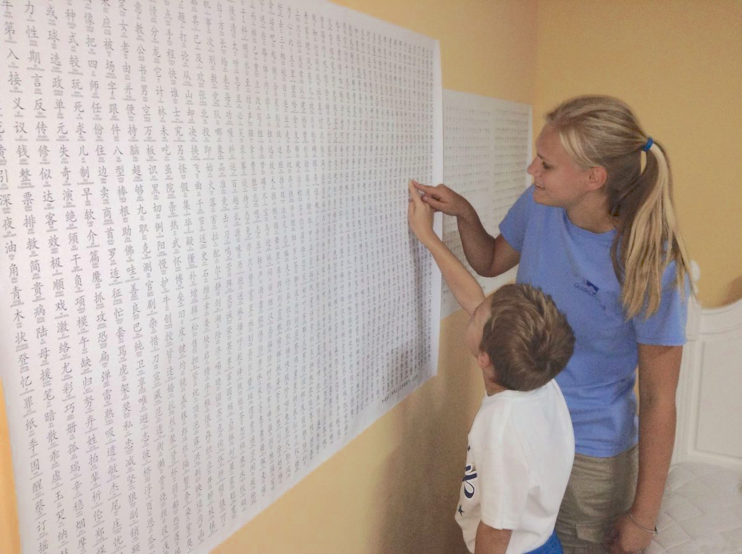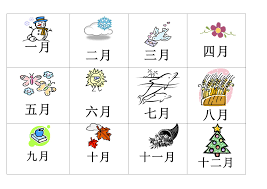Perhaps you are wondering why Chinese for English speakers is perceived as being so difficult.
Or maybe you just want something to point your friends to when they ask you, “Is Chinese hard to learn?”
Either way, in this article we’ll highlight the features of English that you likely take for granted, and compare them with their Chinese counterparts, so you can judge for yourself whether Mandarin Chinese is one of the hardest languages to learn.
Key challenges of learning Chinese for English speakers
Chinese characters vs. English alphabet
If English is your native language, you probably spent the first week or so in primary school learning the 26 characters of the Roman alphabet.
While it may have seemed like quite the struggle when you were six years old, learning the alphabet is one of the only times you were able to advance your language skills so radically in such a short period of time.
The alphabet is so staggeringly useful that, while you may not have known it then, you not only learned the building blocks to English, but hundreds of other languages as well. As far as language technology goes, it’s hard to beat the contribution of an alphabet.
Here’s what learning the alphabet enabled you to do:
- Learn all the words
After learning only 26 “characters”, you will have acquired the building blocks for every single English word you’ll ever learn.
- Look words up in a dictionary
Don’t know what “abnegation” means? Because you know the alphabet, look up “abnegation” in a dictionary is a trivial task.
- Speak words out loud
Perhaps you don’t know what the word ‘abnegation’ means, but if you see it written in a book or magazine, you can likely say it out loud (once you learn the pronunciation rules).It turns out, this is pretty useful. You can do some pretty fantastic things, like ask your friend, “Hey Tom, what does, ‘abnegation’ mean?” (something you can’t do with Chinese, as we’ll discuss in a moment).
- Type every word on a simple keyboard
There are only 26 characters, so keyboards fit nicely on a desk, or even on a small touchscreen display.
- Arrange things in a predictable order
Sometimes there is an obvious way to put things in order. For example, arranging people by height if you’re trying to choose people for your basketball team.But sometimes there is no obvious way to arrange things, and yet a predictable order is still helpful. No problem, just put things in alphabetical order.Just how great is alphabetical order? Imagine organizing books in a library, or indexes in the back of a book, or a list of names for each table at a wedding party, or names of stock tickers, or anything else… without alphabetical order.
All that stuff above is pretty cool, right? Okay, now let’s see what Chinese has to offer.
Chinese has no alphabet
Time for your first day of Chinese for English speakers class. We won’t learn all the characters today, but here is about 0.002% of them:
(This is definitely not how to learn Chinese characters.)
But the reality remains: there are tens of thousands of “characters” to learn.
Is each Chinese character a word?
It’s easy to confuse ‘characters’ and ‘words’, so we’ll just clear it up now: A word might be a single character. Like 你. Or it might be multiple characters put together. Like 你好.
See our article on Proven methods to learn Chinese vocabulary.
In Chinese, looking up words is a challenge
Without an alphabet, dictionaries are considerably more challenging to use.
With traditional, physical dictionaries, you might be able to look up words according to their character components or radicals (fancy terms for the smaller pieces-of-each-character that come together to comprise individual characters). Doing so is very slow.
Modern, digital dictionaries let you hand-write the character, which is certainly a lot faster.
(Some of you right now: “What about Pinyin?!” I know. We’ll get to that below).
In Chinese, saying words out loud is impossible unless you already know the word
When you come across a new word (or individual character) in Chinese, you won’t know how it is pronounced. (While advanced learners may say, “yes, but the components often provide hints as to how to pronounce it”, the reality is most students aren’t advanced learners, and even those rules aren’t deterministic).
Not being able to say new words out loud leaves you at a considerable disadvantage: how do you ask someone what the word means? Answer: you either a) describe the character based on its components and hope they’ll be able to picture it accurately in their mind or b) show them the character (not say it out loud).
Typing in Chinese is like playing a video game
With thousands of unique characters, native English speakers often wonder how to type in Chinese. The first method is typing according to strokes. While this is quite a simplified explanation, you essentially tap each “stroke” until you build up the character you want.
The second method has been made possible only in recent years, which is hand-writing each stroke with your finger on a touch-screen. When you’re finished, several options for which character you were trying to type will appear, and you can select the correct one.
Pinyin introduces a much better (but still not great) way to “type” in Chinese. We’ll explain all about Pinyin below.
Also, you can check our blog post on how to type in Chinese to learn more.
In Chinese, there is no easy way to order words
A less commonly known (but certainly very challenging) aspect of Chinese for English speakers is that ordering things is no longer a trivial task.
As it turns out, “alphabetical order” is only possible when there is an alphabet.
So how is anything ordered in Chinese?
Ordering can be done in several ways. Here are a few:
- By stroke order (which lines you draw first)
- By radical (one of the more “important” components to a character)
- By number-of-strokes (anywhere from 1 to 64, seriously!) in the character
As you may have guessed, these ordering methods are pretty terrible. They narrow down what you’re looking for, and then you have to search through whatever choices still fit your current sort.
Physical dictionaries can’t even agree on which sorting method is best, so they usually include multiple indexes, each using its own sorting method.
Pinyin to the Rescue! (…sort of)
Since alphabets are so useful, why not give one to Chinese?
That’s exactly what Chinese linguists did in the 1950s.
Pinyin is a way to pronounce Chinese words using the Roman alphabet. (Note, even though the alphabet looks the same, the pronunciation rules are completely different. Which is why President “Xi” sounds like “She”).
Pinyin is definitely useful for English-speaking Chinese learners. 你好 can be “written” in Pinyin like this: ni hao.
Those Roman characters can then be spoken according to Pinyin pronunciation rules, in the same way that English words can be spoken according to English pronunciation rules.
Typing is now extraordinarily easier: you type the pinyin pronunciation and then pick from amongst all the matching homonyms & homographs. (This activity is why Hack Chinese focuses on character recognition, not hand-writing).
All problems solved then, right?
Not even close. Here’s why:
- Chinese is written with characters, not Pinyin. So while you can initially learn to pronounce Mandarin words by memorizing the character and Pinyin together, you’ll see only characters when you’re exploring China (or reading, or watching subtitles, etc.)
- Chinese has so many homonyms and homographs that writing exclusively in Pinyin is not an option (more on this later).
- While things can be (and often are) ordered alphabetically according to Pinyin, not all Chinese people know Pinyin. One reason for this is that Pinyin is based on standard Mandarin pronunciation in a country with dozens of actively used Chinese dialects that don’t match up with Pinyin pronunciation.
Words in Chinese are not separated by spaces
Words in English are separated by spaces. Separating each word with a space makes so much intuitive sense, you’ve probably never even considered it as an “advantage” in English.
But it is.
It lets your mind parse individual words with considerably less effort, which is great for experienced readers, but even better for learners who are trying to figure out where one word starts and another stops.
Andwhileyouprobablycouldlearn toreadsentenceswithoutspaces, it certainly isn’t fun.
Without spaces to separate each word, students can easily be confused as to when one word finishes and the next one starts.
While native speakers (and anyone with sufficient practice) eventually learn to parse the words this way, it’s mostly because they recognize all the words already and use as many context clues as are available — not because omitting spaces actually helps anyone or makes any sense at all. However, the lack of word separation in Chinese makes it extremely difficult to read for English speakers.
Not all Tonality is Equal
Tone changes the meaning of English sentences
In English, “he wore a tuxedo” can mean different things when spoken with different tonality.
| Spoken with flat, emotionless tone.
“He wore a tuxedo” > Speaker is indicating that the man in question wore a tuxedo. |
| Emphasis on “tuxedo”, with rising pitch.
“He wore a tuxedo?” > Speaker is expressing doubt, disbelief or surprise that the man in question wore a tuxedo. |
The words spoken are exactly the same. “He + wore + a + tuxedo”.
But the meaning is very different.
That’s how tonality works: it’s an added dimension of language that can alter the meaning without altering the content.
Tone changes the meaning of Chinese syllables
Chinese has tonality too. But the important tonality in Chinese isn’t at the sentence level, but at the syllable level.
If your mind is exploding right now, that makes sense. Because as you might have guessed, this complicates the language exponentially.
In case you forgot, a syllable is the smallest unit of pronunciation that includes a vowel:
- One syllable: “What”
- Two syllables: “Water”
- Three syllables: “Flamingo”
To see how tones work with Chinese, let’s use the classic example and inspect the Chinese syllable “ma”.
Learning Chinese tones
| Syllable spoken (written in pinyin) | Tone (pitch) | Meaning |
| ma | Flat, constant (relatively high) pitch | mother |
| ma | Rising pitch | hemp |
| ma | Pitch that starts high then dips low before returning a little higher | horse |
| ma | Pitch that starts high and ends low | to scold someone |
| ma | Fast | indicates that the preceding sentence was a question |
So if someone says ‘ma’ in Chinese, it could mean one of five completely unrelated things.
Terribly Unfun Fact
There are actually around 40 potential meanings for “ma” in Chinese. See the below section on homonyms and homographs to deepen your existential crisis.
There are five tones in Chinese, and they are usually referred to with their ordinal number 1 to 5.
Five tones in Chinese
| Tone | Pitch |
| 1st | Level and relatively high |
| 2nd | Starts lower and ends higher |
| 3rd | Starts relatively high, dips lower, then returns higher |
| 4th | Starts high and falls quickly |
| 5th | Neutral and fast |
With toneless pinyin, you’d be left guessing what the syllable meant.
Fortunately, there are two ways to add tonality to Pinyin: tone marks or tone numbers.
Chinese tone ma
| Tone Marks | mā má mǎ mà ma |
| Tone Numbers | ma1 ma2 ma3 ma4 ma5 |
We recommend using tone marks instead of tone numbers for two reasons:
- Tone marks make the pitch obvious. For example, the first tone is flat, and the tone mark looks that way: mā. The second tone starts low and rises, and the tone mark looks that way: má. Likewise for 3rd, 4th, and 5th tones: mǎ, mà and ma.
- It is cleaner and easier to read, especially when writing a whole sentence:
| Tone marks | Wǒ hěn xǐhuan xué Zhōngwén. |
| Tone numbers | Wo3 h3 xi3 huan5 xue2 Zhong1 wen2 |
Let’s add everything together into one chart, and add the associated character for completeness, too:
Chinese tones chart
| 1st tone (mā) Spoken with level and relatively high pitch. |
妈 mother |
| 2nd tone (má) Pitch starts low and ends high. |
麻 hemp |
| 3rd tone (mǎ) Pitch starts high, dips lower, returns high |
马 horse |
| 4th tone (mà) Pitch starts high, falls quickly |
骂 to scold |
| 5th tone (ma) Neutral |
吗 indicates a question |
Chinese tones change depending on the context
As if syllable-level tones didn’t make Chinese for English speakers complicated enough, there are also several rules that change the tone based on surrounding words. Here’s an example:
“You” is pronounced “ni” with the third tone: nǐ.
“Good” is pronounced “hao”, also with the third tone: hǎo.
“Hello” is the combination of the words “you” and good”, like this: nǐ hǎo.
And yet, when spoken, you don’t actually speak it as it’s written:
| Original Tones | nǐ hǎo |
| Spoken Tones | ní hǎo |
| What Changed? | The tone on ni changed from 3rd tone (nǐ) to 2nd tone (ní). |
| Why? | When two 3rd-tone syllables are next to each other, the first syllable is spoken with a 2nd tone. |
The above is just one of several rules that must be accounted for when learning, speaking, and listening to spoken Chinese. (Shameless plug: Hack Chinese lets students display both the original and “spoken” tone marks while studying, along with indicators of when and where they changed).
Homonyms & Homographs
Homonyms in English are challenging
I suspect many readers have forgotten their grammar lessons from primary school, so here is a quick refresher:
| Homonyms
Words that are spelled the same and sound the same, but have different meanings. The dog’s bark vs. the bark on the tree. |
| Homographs
Words that are spelled the same, but have different sounds and/or meanings. A lead pencil vs. she will lead us to victory. |
| Homonyms | Words that are spelled the same and sound the same, but have different meanings. | The dog’s bark vs. the bark on a tree. |
| Homographs | Words that are spelled the same, but have different sounds and/or different meanings. | A lead pencil vs. she will lead us to victory. |
Like it or not, the process of learning English is made more challenging because of homonyms and homographs. But they are relatively few in number, and so are treated as exceptions.
They must be learned, for sure, but they generally don’t keep students up at night.
Homonyms in Chinese are soul-crushing
The best way to understand the magnitude of this is with an example.
Let’s look at a famous poem called ‘Ten Stone Lions’.
First, in here is the original Chinese (don’t worry if you don’t understand the meaning):
石室诗士施氏,嗜狮,誓食十狮。氏时时适市视狮。十时,适十狮适市。 是时,适施氏适市。氏视是十狮,恃矢势,使是十狮逝世。氏拾是十狮尸,适石室。石室湿,氏使侍拭石室。石室拭,氏始试食是十狮尸。食时,始识是十狮,实十石狮尸。试释是事。
Next, let’s look at the English translation:
A poet named Shi lived in a stone room, fond of lions, he swore that he would eat ten lions. He constantly went to the market to look for ten lions. At ten o’clock, ten lions came to the market and Shi went to the market. Looking at the ten lions, he relied on his arrows to cause the ten lions to pass away. Shi picked up the corpses of the ten lions and took them to his stone room. The stone room was damp. Shi ordered a servant to wipe the stone room. As the stone den was being wiped, Shi began to try to eat the meat of the ten lions. At the time of the meal, he began to realize that the ten lion corpses were in fact ten stone lions. Try to explain this matter.
Finally, let’s take a look at how it sounds in Chinese, using Pinyin with tone marks:
shī shì shí shī shǐ shí shì shī shì shī shì, shì shī, shì shí shí shī. shì shí shí shì shì shì shī. shí shí, shì shí shī shì shì. shì shí, shì shī shì shì shì shì. shì shì shì shí shī, shì shǐ shì, shǐ shì shí shī shì shì. shì shí shì shí shī shī, shì shí shì. shí shì shī, shì shǐ shì shì shí shì. shí shì shì, shì shǐ shì shí shí shī shī. shí shí, shǐ shì shì shí shī shī, shí shí shí shī shī. shì shì shì shì.
If your brain hasn’t melted yet, here is a YouTube Video of a native Chinese person reading this poem.
If you’re ready to abandon learning Chinese before even starting, you’re not alone. The top comments on the above video are the likes of, “translation: you will never learn Mandarin”, “RIP my desire to learn Chinese,” and, “I’m sure Chinese people are just trolling us”.
“Ten Lions” is clearly a contrived example. No actual Chinese person speaks like this, and I suspect you could make a poem in English with lots of homonyms and homographs too.
But I am also willing to bet that it would not drop you into the same depths of despair as the above.
If you are curious to learn more examples like this, check out our article on popular Chinese tongue twisters.
Let’s summarize what we’ve learned so far
Differences between Chinese and English
These contrasts in the two languages make it hard to learn Chinese for English speakers!
| Alphabet
With English, having an alphabet enables English speakers to:
Chinese has no alphabet. It has adopted the Roman alphabet in the form of “Pinyin” (for learning pronunciation), but it’s advantages are limited:
|
| Words
In English, every word is made up of 1 or more characters (letters) from the 26-character alphabet, and every word is separated by a space. In Chinese, every word is a distinct sequence of often complicated characters that needs to be memorized (there are ~50,000+, although the first 5,000 will probably be enough for most students’ needs), and there are no spaces separating individual words. |
| Tones
In English, tonality can add emotion (or sometimes even change the meaning) of sentences. In Chinese, tonality is at the syllable level. With five distinct tones, a sentence with 10 syllables could theoretically have 5^10 (close to ten million) meanings. (In practice, context makes this less challenging than it seems, which should be obvious considering actual humans successfully speak Chinese). |
| Tone change rules
English has no rules dictating how tones should change. In Chinese, several rules dictate changing the tone of pronounced words, depending on the words around it. This Challenging to learn to do, even more challenging to learn to listen for. |
| Homonyms & Homographs
In English, dogs “bark” while trees have “bark”, and people in front “lead” the way while pencils are filled with “lead”. Homonyms & homographs in English would be significantly more confusing if context wasn’t there to help you. In Chinese, virtually every word is a homonym. The Chinese syllable “shi” has over fifty definitions. If you also know the tone, the potential meanings are reduced. Add in context, and you’ve probably narrowed the potential meaning down to just a handful. In written Chinese, the characters are unique, so this problem does not exist. |
And yet: Chinese is the most widely spoken language in the world
Billions of people speak Mandarin Chinese (or a close dialect) with ease.
But for the rest of us, learning Chinese as a second language is a daunting challenge: it lacks the most useful linguistic invention ever (the alphabet), it has syllable-level tones (with rules that modify them according to context), and so many homonyms that they are the rule, not the exception.
But there are also reasons to be excited about learning Chinese. Grammar is a bit easier, verb conjugation just isn’t a thing, and there are no gender for nouns, just to name a few.
And it is hard to understate how good it feels when you’re able to speak to over a billion more people on Earth (or just watch TV shows from China). This is why learning Chinese for English speakers is getting so popular.
If you choose to learn Chinese, make sure you put extra thought into how to be efficient with your study time. It’s easy to fall into doing things that feel like progress, but don’t advance you to your goal. For example, learning to hand-write characters may seem like a no-brainer, until you realize that it’s not particularly useful (and certainly not necessary) in the modern world. Unless you’re enraptured by the process of hand-writing, there are probably other things you could be doing with your time that gets you to conversational fluency faster.
A few percentage extra points of efficiency here and there, and you just might end up with some seriously enviable proficiency in the world’s hardest language.





